Author: Alex Pack, Alex Botte, Partners at Hack VC
Translated by: Yangz, Techub News
Abstract
- Ethereum's performance in this cycle has been inferior to mainstream coins like Bitcoin and Solana. At least from the perspective of critics, the culprit is Ethereum's strategic decision to adopt a modular approach. But is this true?
- In the short term, the answer is yes. We find that Ethereum's shift to a modular architecture has impacted the price of ETH due to reduced fees and decreased token consumption.
- However, if we consider the combined market capitalization of Ethereum and its modular ecosystem, the situation changes. In 2023, the value generated by Ethereum's modular infrastructure tokens is roughly equivalent to the entire value of Solana, both around $50 billion. Yet, in 2024, the overall performance of these tokens is not as strong as Solana. Additionally, the profits from these tokens primarily benefit teams and early investors, rather than ETH token holders.
- From a business strategy perspective, Ethereum's modular transition is a reasonable way to maintain its ecological dominance. The value of a blockchain depends on the scale of its ecosystem; although Ethereum's market share has dropped from 100% to 75% over nine years, this share is still significant. We compare it to Web2 cloud computing company Amazon Web Services, whose share fell from nearly 100% to 35% during the same period.
- From a longer-term perspective, the greatest benefit of Ethereum's modular approach is that it enables the network to withstand technological advancements that could render it obsolete in the future. Through L2, Ethereum successfully navigated the first major "catastrophe" of L1, laying a solid foundation for its long-term resilience (albeit with trade-offs).
What Went Wrong?
Compared to Bitcoin and Solana, Ethereum has underperformed in this market cycle. Since 2023, Ethereum has risen by 121%, while Bitcoin and SOL have increased by 290% and 1452%, respectively. We have heard many explanations for this phenomenon, claiming that the market is irrational, the technical roadmap and user experience are lagging behind peers, and Ethereum's market share is being taken by competitors like Solana. So, is Ethereum destined to become the AOL or Yahoo of the cryptocurrency space?
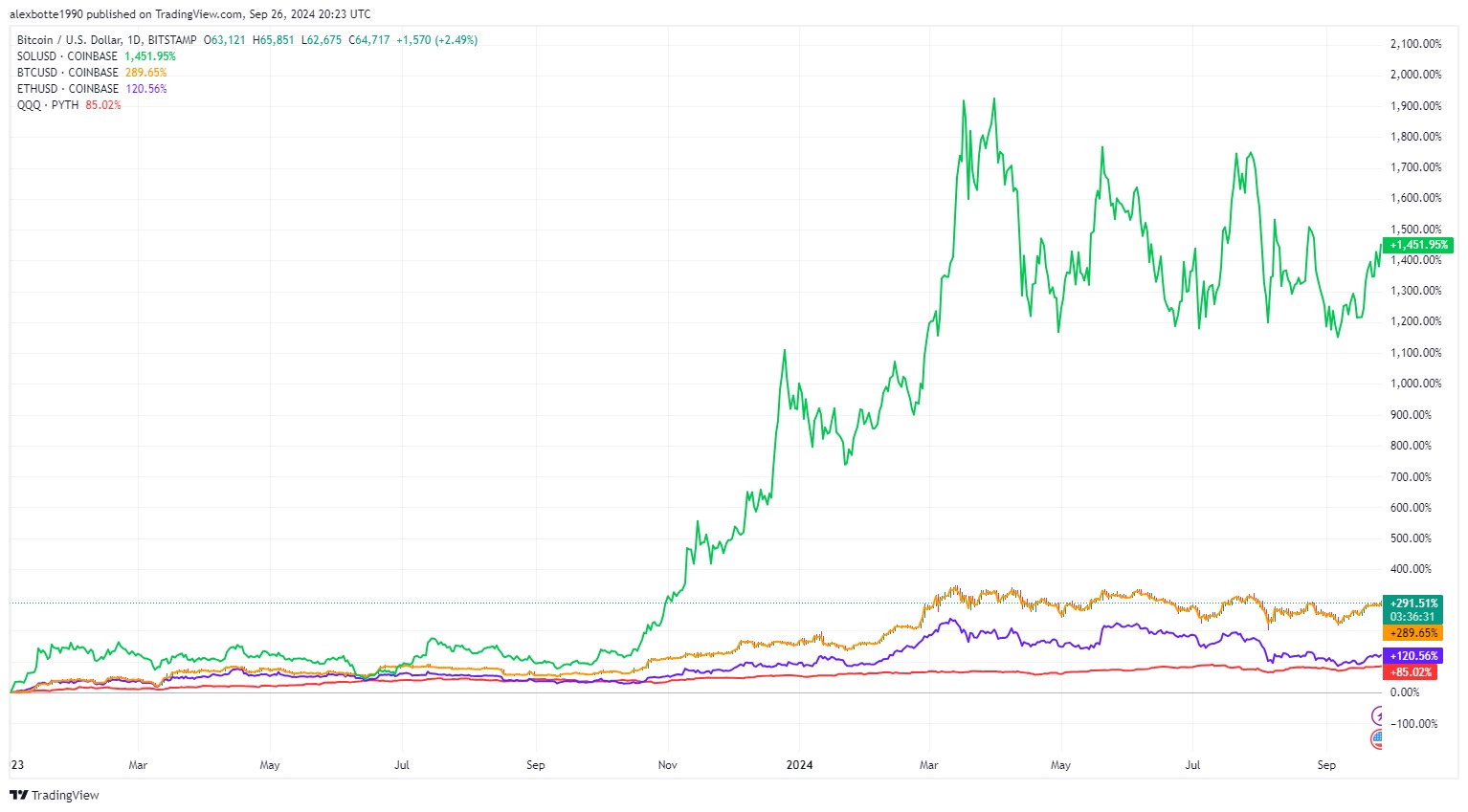
The real culprit behind Ethereum's poor performance is actually a very intentional strategic decision made nearly five years ago: the shift to a modular architecture, followed by the decentralization and splitting of its infrastructure roadmap.
In this article, we will explore Ethereum's modular approach, using data-driven analysis to assess how this strategy affects ETH's short-term performance, Ethereum's market position, and its long-term prospects.
How Crazy is Ethereum's Strategic Shift to a Modular Architecture?
In 2020, Vitalik and the Ethereum Foundation (EF) made a bold and controversial call: to split the various components of the Ethereum infrastructure stack. Ethereum would no longer handle all aspects of the platform (execution, settlement, data availability, ordering, etc.), but would intentionally allow other projects to provide these services in a composable manner. Initially, they encouraged new Rollup protocols to handle execution issues as Ethereum L2 (see Vitalik's 2020 article "The Rollup-Centric Ethereum Roadmap"), but now there are hundreds of different infrastructure protocols competing to offer what was once considered L1 exclusive technical services.
To better understand how radical this idea is, consider the situation in Web2. A Web2 service similar to Ethereum is Amazon Web Services (AWS), the leading cloud infrastructure platform for building centralized applications. Imagine if, when AWS launched 20 years ago, it decided to focus solely on its flagship products, such as storage (S3) and computing (EC2), rather than the dozens of different services it offers today. AWS would have missed out on excellent revenue opportunities and would not have been able to market its expanding suite of services to customers. With a full suite of product services, AWS could have created a "walled garden," making it difficult for its customers to integrate with other infrastructure providers, thereby locking them in. Of course, that is exactly what happened. AWS now offers dozens of services, making it hard for customers to leave its ecosystem, and its revenue growth has been astonishing (growing from hundreds of millions in the early days to about $100 billion in annual revenue now).
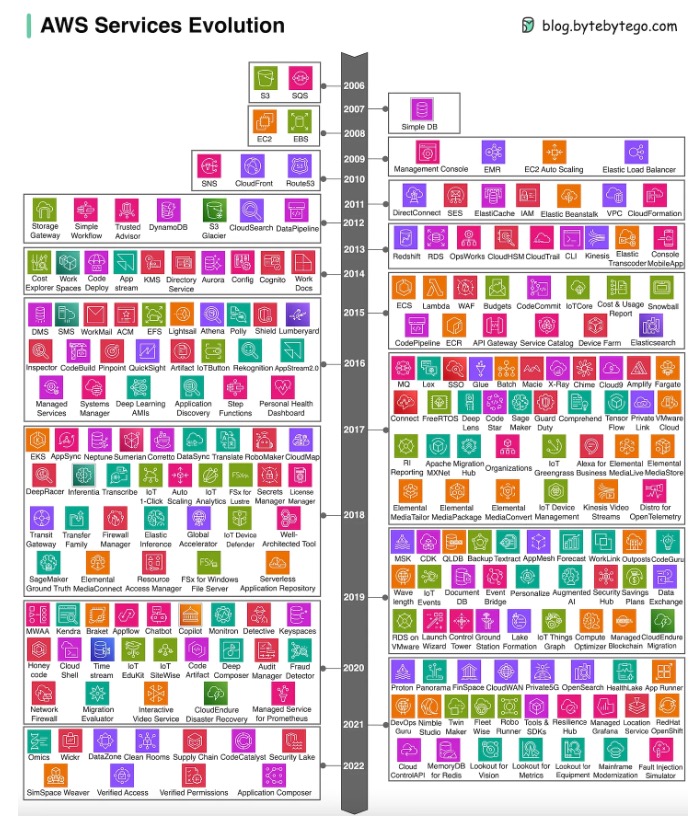
However, in terms of market share, over time, AWS's market share has gradually been taken by other cloud computing providers, with competitors like Microsoft Azure and Google Cloud steadily increasing their market share each year, causing AWS's market share to drop from an initial 100% to around 35% now.
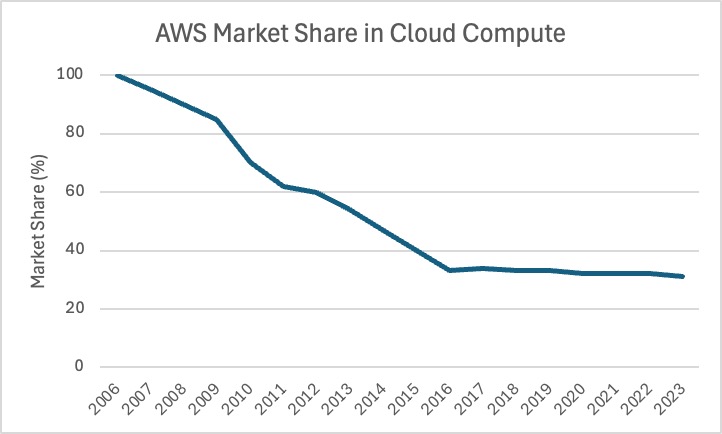
What if AWS had taken a different approach? What if AWS acknowledged that other teams might build certain services better and opened its APIs, prioritized composability, and encouraged interoperability instead of creating a locked environment? AWS could have allowed developers and startups to build complementary infrastructure, resulting in better, more specialized infrastructure, creating a more developer-friendly ecosystem and a better overall experience. This would not have brought AWS more revenue in the short term, but it could have given AWS a larger market share and a more vibrant ecosystem than its competitors.
Nevertheless, this might not have been worthwhile for Amazon. As a publicly traded company, it needs to optimize for revenue, not for a "more vibrant ecosystem." For Amazon, splitting and modularizing may not be reasonable. But for Ethereum, it might be reasonable because Ethereum is a decentralized protocol, not a company.
Decentralized Protocols, Not Companies
Like companies, decentralized protocols also have usage fees, or what could be called "revenue" to some extent. But does this mean that the value of the protocol should be based solely on this revenue? No, that is not the case.
In Web3, the value of a protocol depends on the overall activity on its platform, relying on having the most active builders and user ecosystem. Below is our analysis of the relationship between the token prices of Bitcoin, Ethereum, and Solana and the Metcalfe value (a measure of the number of users in a network). In all cases, token prices are highly correlated with Metcalfe value, and this relationship has persisted for years, while for Bitcoin, this relationship has lasted over a decade.
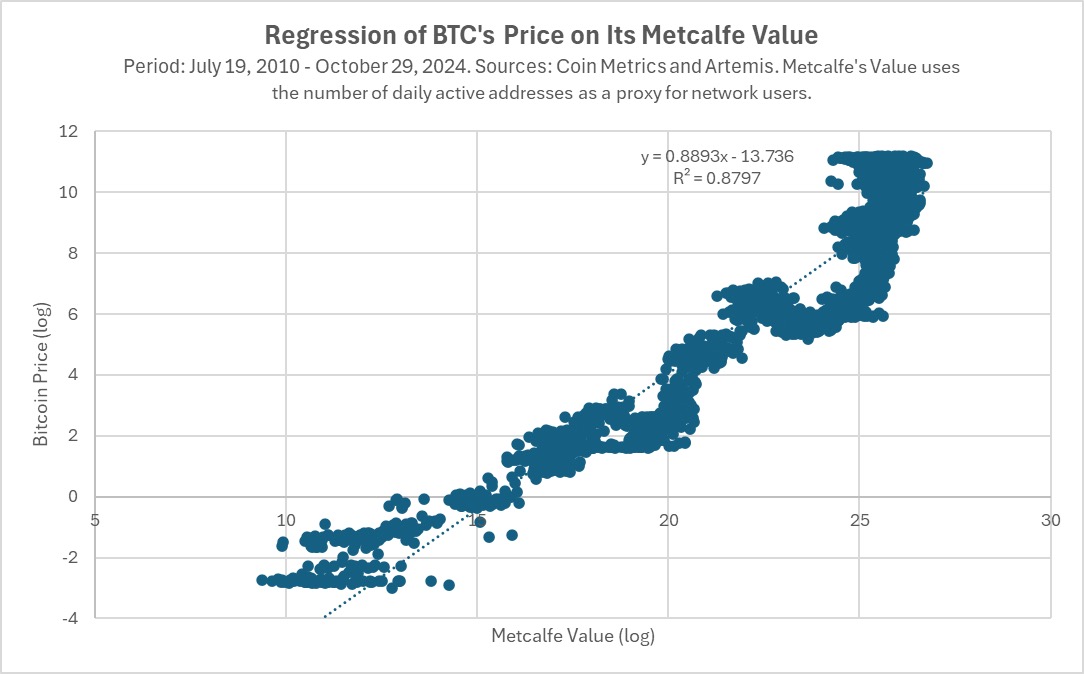
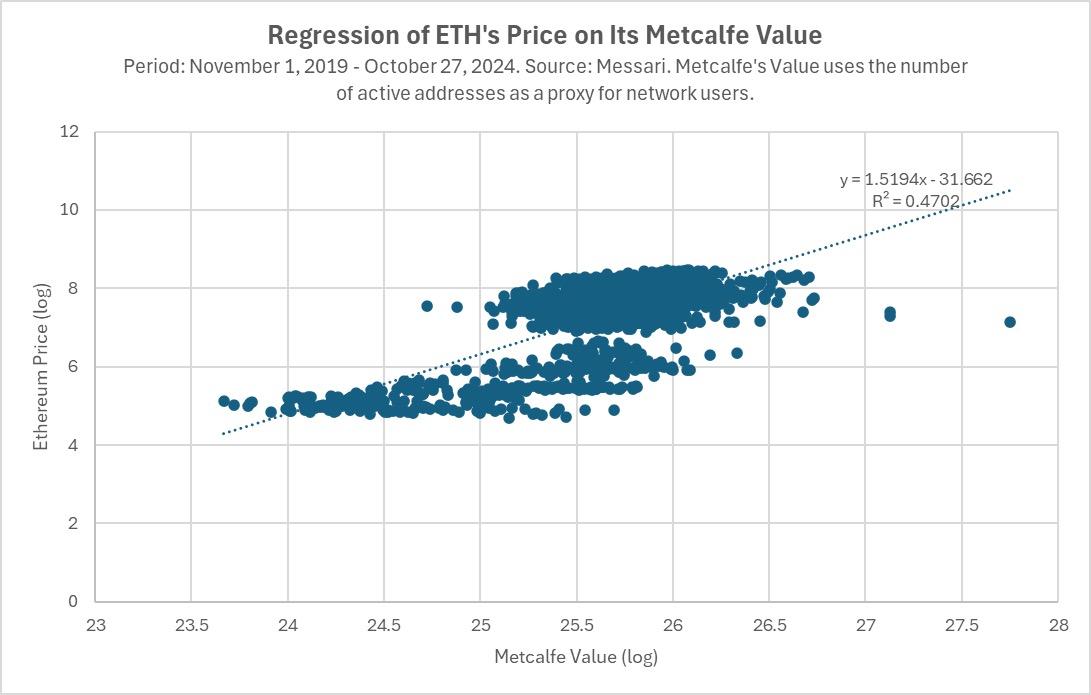
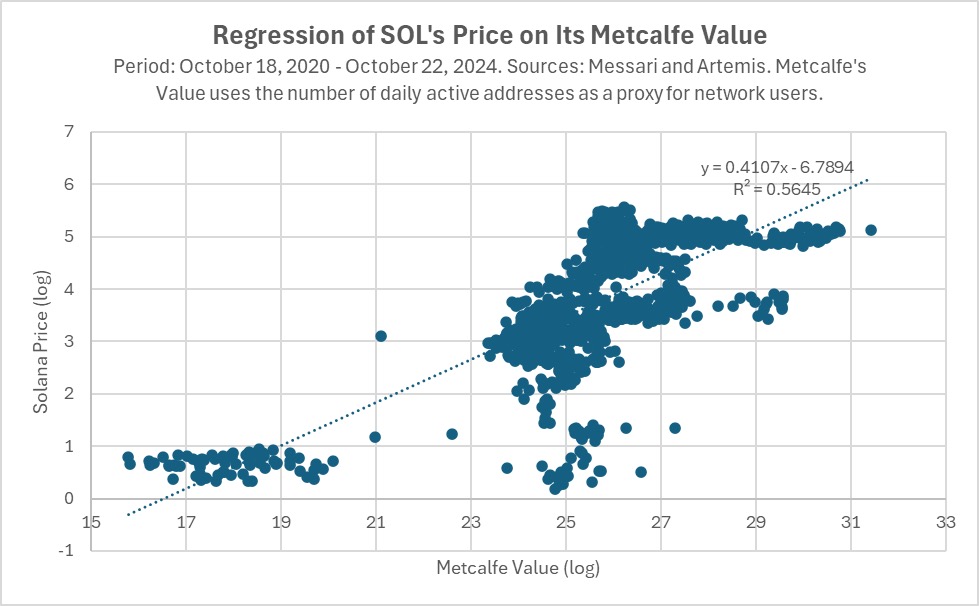
Why is the market so focused on ecosystem activity when pricing these tokens? Stocks are priced based on growth and profitability. Currently, the theories about how blockchains accumulate value for their tokens are still immature and have little explanatory power in the real world. Therefore, it is reasonable to value them based on the strength of the network (such as user numbers, assets, activity, etc.).
More specifically, token prices should actually reflect the future value of their networks (just as stock prices reflect the future value of companies, not their current value). This leads to a second reason why Ethereum might want to modularize: to use modularization as a form of "future-proofing," increasing the likelihood of Ethereum maintaining its dominance in the long term.
In 2020, when Vitalik wrote the article "The Rollup-Centric Roadmap," Ethereum was in its 1.0 phase. Ethereum was the first smart contract blockchain in history, but it was clear that there would be several orders of magnitude (OOM) improvements in scalability, cost, and security in the future. The greatest risk for pioneers is that they adapt slowly to new technological paradigm shifts, thereby missing the next OOM leap. For Ethereum, this means the transition from PoW to PoS and the shift to a blockchain that scales 100 times. Ethereum needs to cultivate an ecosystem capable of scaling and achieving significant technological advancements, or it risks becoming the Yahoo or AOL of its era.
In the world of Web3, decentralized protocols have replaced the position of companies, and Ethereum believes that, in the long run, nurturing a strong modular ecosystem is more valuable than controlling all infrastructure, even if it means relinquishing control over the infrastructure roadmap and core service revenues.
Next, let’s look at how this modular decision is realized through data.
Ethereum's Modular Ecosystem and Its Impact on ETH
We will examine the impact of modularization on Ethereum from the following four aspects:
- Short-term price (adverse)
- Market capitalization (somewhat favorable)
- Market share (favorable)
- Future technology roadmap (debatable)
Fees and Price: Adverse
In the short term, Ethereum's decision has had a noticeable impact on the price of ETH. Although Ethereum's price has been significantly rising from its lows, there have been periods where Ethereum's performance has lagged behind many competitors like Bitcoin and SOL, and even the Nasdaq Composite Index.
This is largely undoubtedly due to its modular strategy.
The first way Ethereum's modular strategy affects ETH prices is by lowering fees. In August 2021, Ethereum launched EIP-1559, which caused excess fees paid to the network to result in ETH being burned, thereby limiting supply. This is somewhat akin to stock buybacks in the public stock market, which can exert positive pressure on prices. In fact, it did have that effect for a time.

However, with the introduction and development of L2s for execution, and alternative data availability (DA) layers like Celestia, Ethereum's fees have decreased. By relinquishing core revenue services, both Ethereum's fees and revenues have declined. This has had a significant impact on the price of ETH.
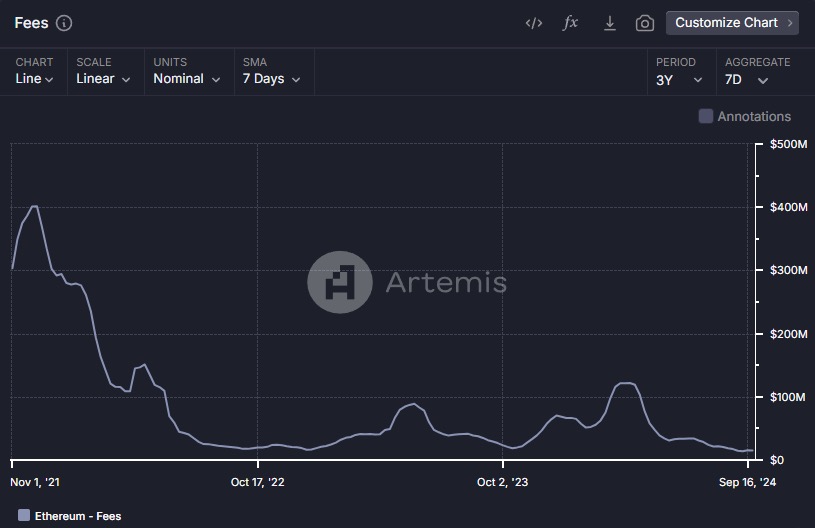
Over the past three years, the relationship between Ethereum fees (in ETH) and ETH prices has been statistically significant, with a weekly correlation of +48%. If Ethereum's generated fees decrease by 1000 ETH in a week, the average depreciation of ETH price is $17.

Of course, these fees do not disappear; they flow to new blockchain protocols, including L2s and DA layers, etc. This leads to a second reason why the modular strategy may harm ETH prices: most of these new blockchain protocols have their own native tokens. Previously, investors only needed to purchase one infrastructure token to access all the exciting growth happening in the Ethereum ecosystem, but now they must choose from many different tokens (CoinMarketCap lists 15 tokens in its "modular" category, with dozens more accepting venture capital in private markets).
This new category of modular infrastructure tokens may harm ETH prices in two ways. First, if we view blockchains as companies, they should be fully value-added, and the total market capitalization of all "modular tokens" would become the market capitalization of ETH. This is typically how it works in the stock world. When companies split, the market capitalization of the old company usually decreases as the market capitalization of the new company increases.
However, for ETH, the situation may be worse. Most cryptocurrency traders are not particularly sophisticated investors, and when faced with the need to purchase dozens of tokens to gain exposure to "all the cool growth happening on Ethereum" rather than just one token, they may feel overwhelmed and simply not buy any tokens. This psychological burden and the transaction costs of purchasing a basket of tokens instead of just one may harm the prices of both Ethereum and the modular tokens.
Market Capitalization: Favorable (to some extent)
Another way to estimate the impact of Ethereum's modular roadmap on its success is to look at the changes in its absolute market capitalization over time. In 2023, Ethereum's market capitalization increased by $128 billion. In contrast, Solana's market capitalization grew by $54 billion. While the absolute numbers are higher, Solana's growth base is much lower, which is why its price increased by 919%, while ETH only increased by 91%.
However, when considering the market capitalization of all the new "modular" tokens brought about by Ethereum's modular strategy, the situation changes. In 2023, this number increased by $51 billion, roughly on par with Solana's market capitalization growth.
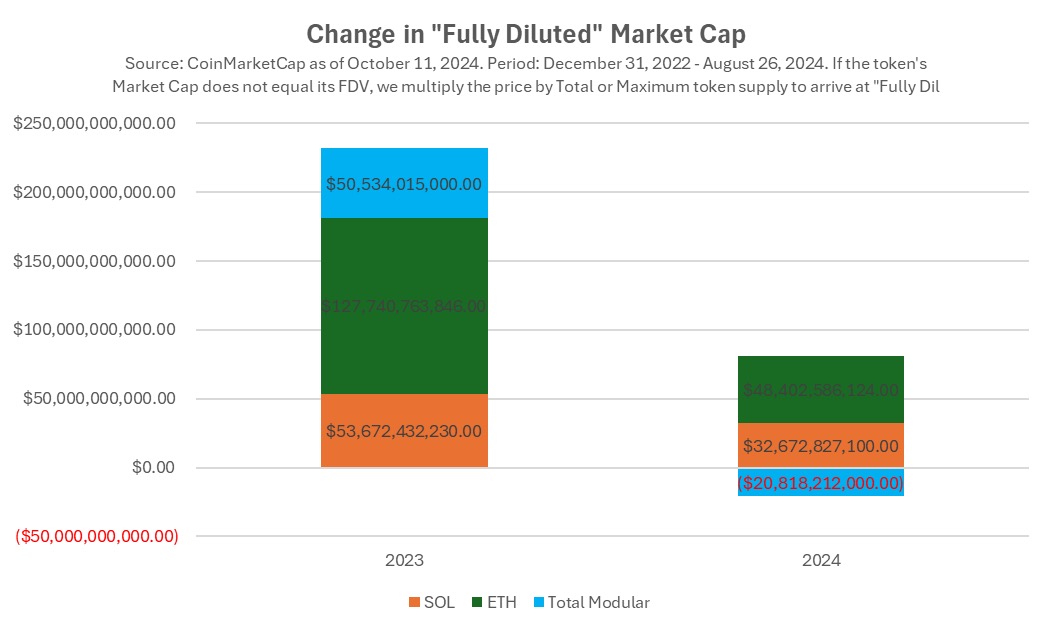
What does this indicate? One explanation is that with the shift to a modular strategy, the Ethereum Foundation has created value for a modular infrastructure ecosystem consistent with Ethereum that is equivalent to that of Solana. Not to mention the $128 billion market capitalization value it created for itself. Imagine how envious Microsoft or Apple would be if they spent years and billions of dollars trying to build their own developer ecosystems around their products, achieving what Ethereum has.
However, the situation in 2024 is not the same. SOL and ETH continue to grow (albeit at a slower rate), while the market capitalization of modular blockchains is declining overall. This may indicate that the market has lost confidence in the value of Ethereum's modular strategy in 2024, or it could be pressure from token unlocks. Of course, it may also be that the market is overwhelmed by the psychological costs of buying a basket of tokens to go long on Ethereum-related infrastructure, whereas they only need to purchase one token to go long on the Solana technology ecosystem.
Let’s shift from price trends and market signals to the actual fundamentals themselves. Perhaps the market in 2024 is wrong, and the market in 2023 was right. Has Ethereum's modular strategy helped or hindered it in becoming the leading blockchain ecosystem and cryptocurrency?
Ethereum Ecosystem and ETH's Dominance: Favorable
In terms of fundamentals and usage, the infrastructure consistent with Ethereum is performing exceptionally well. Among its peers, Ethereum and its L2s have the highest total value locked (TVL) and fees, being 11.5 times that of Solana, and L2 alone is 53% higher than Solana.
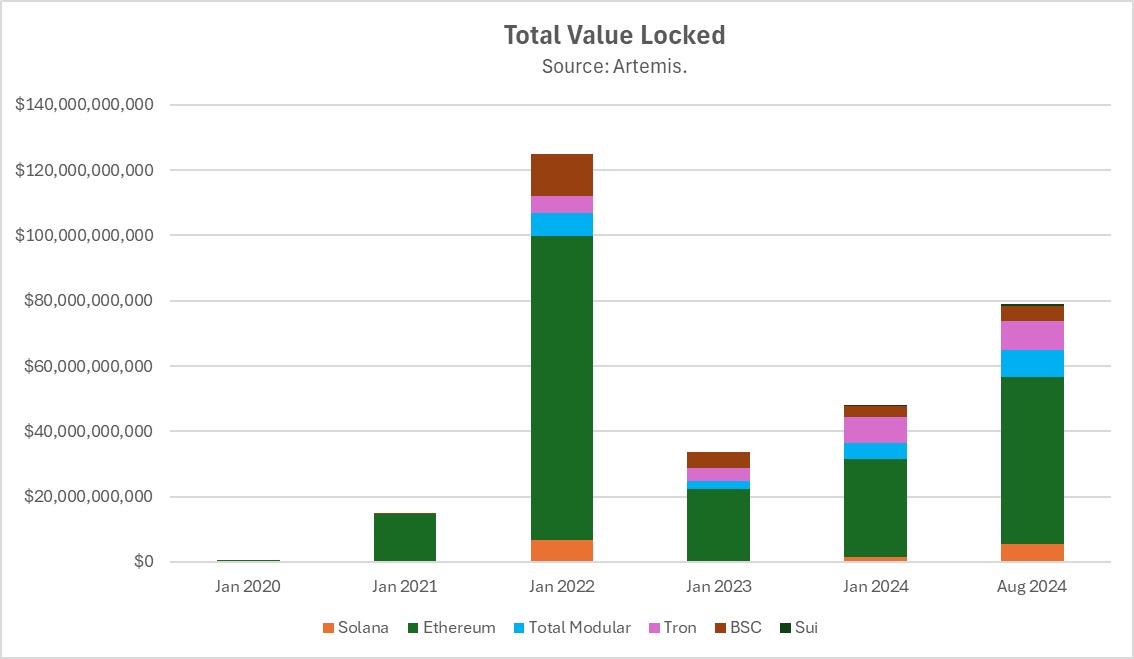
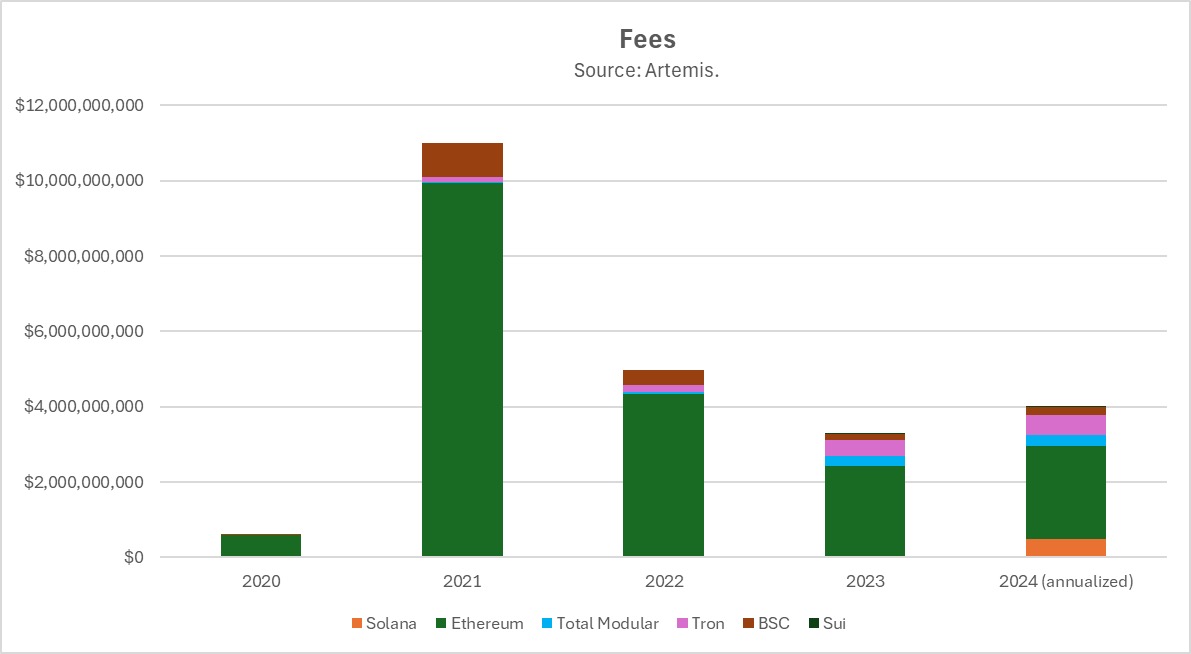
From the perspective of TVL market share, when Ethereum launched in 2015, it had a 100% market share. Despite hundreds of L1 competitors, Ethereum and its modular ecosystem still maintain about 75% market share today.
A drop in market share from 100% to 75% over nine years is quite impressive! For context, AWS's market share fell from 100% to about 35% over a similar period.
But does ETH really benefit from the dominance of the "Ethereum ecosystem"? Or is it the case that Ethereum and its modular components are thriving without treating ETH itself as an asset? It turns out that ETH is an omnipresent part of the broader Ethereum ecosystem. As Ethereum expands to L2, so does ETH. Most L2s use ETH to pay for gas, and ETH in most L2 TVLs is at least 10 times that of other tokens. Observing the table below, we can see the dominance of ETH assets in the three largest DeFi applications in the Ethereum ecosystem across its mainnet and L2 instances.
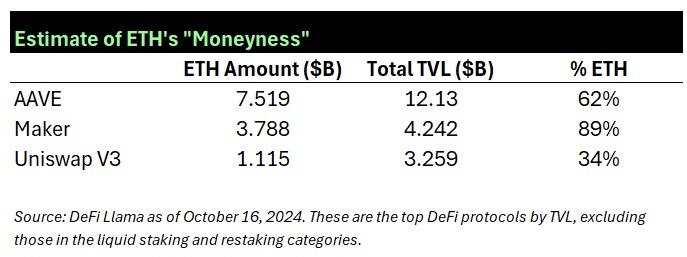
Technical Aspects: Debatable
From the perspective of the technical roadmap, Ethereum's decision to modularize the L1 chain into independent components allows projects to specialize and optimize within their specific domains. As long as these components maintain composability, DApp developers can build using the best existing infrastructure, ensuring efficiency and scalability.
Another significant benefit of modularization is that it provides the protocol with "future-proofing." Imagine if a new technological innovation changes the game; only the protocols that adopt this innovation can survive. This scenario has frequently occurred in technological history, such as AOL, which saw its valuation drop from $200 billion to $4.5 billion for missing the transition from dial-up to high-speed broadband internet. Yahoo also missed the transition to mobile internet due to its slow adoption of new search algorithms (like Google's PageRank), with its valuation dropping from $125 billion to $5 billion.
However, if your technical roadmap is modular, then as L1, you do not have to grasp every new wave of technological innovation; your modular infrastructure partners can seize it for you.
So, has Ethereum's strategy worked? Let’s look at the infrastructure that has been built to match Ethereum:
L2s with best-in-class scalability and execution costs. At least two novel technological approaches have succeeded here, namely optimistic Rollups represented by Arbitrum and Optimism, and zero-knowledge proof-based Rollups represented by ZKSync, Scroll, Linea, and StarkNet. Additionally, there are more high-throughput, low-cost L2s. Cultivating two blockchain technologies that bring OOM improvements in scalability to Ethereum is no small feat. Dozens (if not hundreds) of L1s launched after Ethereum have yet to deliver a 2.0 version with an order of magnitude improvement in scalability and cost. With these L2s, Ethereum has successfully navigated the "first major extinction event" of blockchains, scaling to hundreds of transactions per second (TPS).
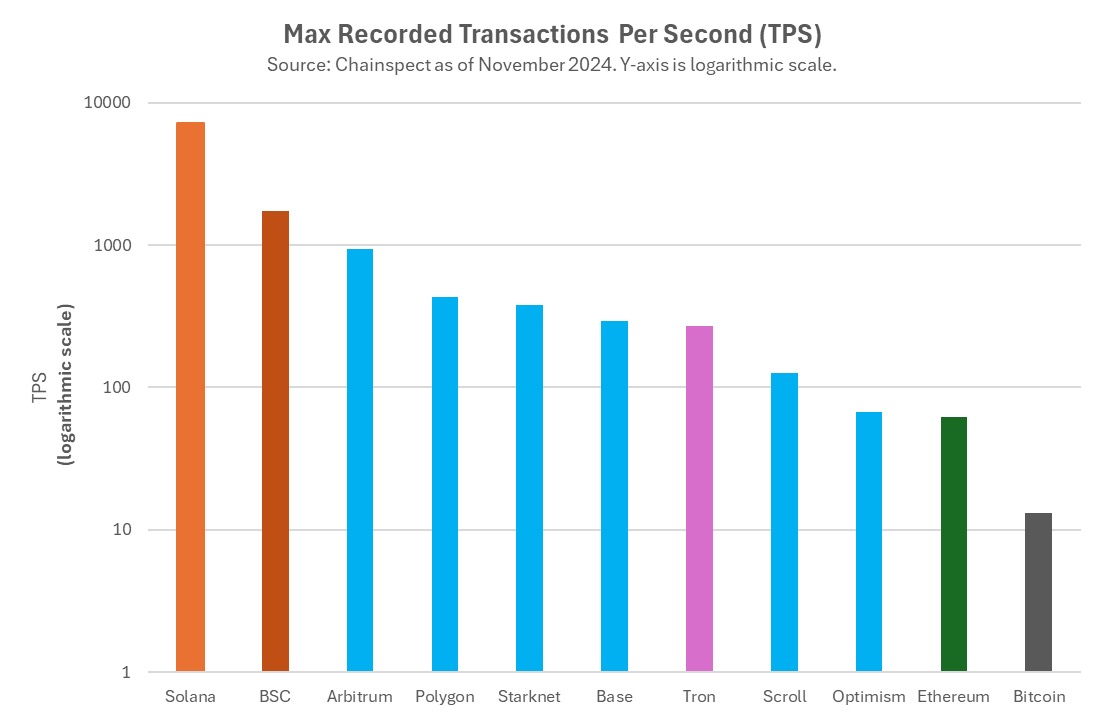
- New blockchain security models. Innovations in blockchain security are crucial for the survival of a protocol, as evidenced by how every mainstream L1 today uses PoS instead of PoW. The "shared security" model pioneered by EigenLayer may be the next significant shift. While other ecosystems have also launched shared security protocols, such as Bitcoin's Babylon and Solana's Solayer, Ethereum's EigenLayer is the pioneer.
- New virtual machines (VMs) and programming languages. One of the biggest criticisms of Ethereum is its Ethereum Virtual Machine (EVM) and its programming language, Solidity. Solidity is a low-abstraction programming language that, while easy to code, is prone to vulnerabilities and difficult to audit, which is one reason why Ethereum-based smart contracts have been hacked. For non-modular blockchains, it is nearly impossible to try using multiple VMs or to replace the initial VM with another, but this is not the case for Ethereum. A new wave of alternative VMs is being built in the form of L2s, allowing developers to code using alternative languages without using the EVM, while still building within the Ethereum ecosystem. Examples in this area include Movement Labs, which is adopting the Move VM built by Meta and promoted by Sui and Aptos; zk-VMs like RiscZero, Succinct, and implementations built by the a16z research team; and teams like Eclipse that are bringing Rust and Solana VM to Ethereum.
- New scalability approaches. Like other internet infrastructures or artificial intelligence, we can expect OOM scalability improvements to occur every few years. Even now, Solana has been waiting for years for its next major improvement, called Firedancer, developed by a team (Jump Trading). Additionally, some new ultra-scalable technologies are being developed, such as parallel architectures from L1 teams like Monad, Sei, and Pharos. If Solana cannot keep up, these technologies could threaten its survival, but Ethereum will not face this issue; it can simply incorporate these technological advancements through new L2s. This is precisely the approach that new projects like MegaETH and Rise are attempting.
These modular infrastructure partners help Ethereum integrate the biggest technological innovations in cryptocurrency into its ecosystem, avoiding disaster and innovating alongside its competitors.
However, this comes at a cost. As Composability Kyle noted, Ethereum's adoption of a modular architecture has added a lot of complexity to the user experience. Average users may find it easier to get started with a monolithic chain like Solana because they do not have to deal with issues like cross-chain and interoperability.
Summary
So, in summary, what has Ethereum's modular strategy brought?
- The modular ecosystem has sent a strong "signal." In 2023, the market granted the growth of modular infrastructure tokens consistent with Ethereum the same attention as that given to Solana, but this was not the case in 2024.
- At least in the short term, the modular strategy has harmed ETH prices due to the resulting lower fees.
- However, when considering the modular approach from a business strategy perspective, things start to make more sense. Over the nine years since Ethereum's inception, its market share has dropped from 100% to 75%, while its Web2 competitor AWS has seen its market share decline to around 35% during the same period. In the world of decentralized protocols, the scale of the ecosystem and the dominance of the token are more important than fees.
- If we consider the modular strategy from a long-term perspective, and the need for Ethereum to withstand potential OOM technological improvements that could lead it to become the AOL or Yahoo of the cryptocurrency space, Ethereum's performance is quite commendable. With L2s, Ethereum has successfully navigated the first "great extinction event" of L1 chains.
Of course, all of this comes at a cost. The composability of Ethereum post-modularization is inferior to that of a bundled monolithic chain, which harms the user experience.
As for when the benefits brought by modularization will offset the cost losses and competition from infrastructure tokens consistent with modular Ethereum, it remains unclear. Certainly, this is good news for the early investors and teams behind these new modular tokens, as they can share in Ethereum's market capitalization, but in many cases, modular tokens have been launched with unicorn valuations, meaning the distribution of these economic benefits is uneven.
In the long run, Ethereum may become a stronger player by investing in nurturing a broader ecosystem. It will not lose ground like AWS in the cloud computing market, nor will it lose everything like Yahoo and AOL in the internet platform wars; it is laying the groundwork to adapt, scale, and thrive in the next wave of blockchain innovation. In an industry driven by network effects, Ethereum's modular strategy may be key to maintaining its dominance as a smart contract platform.
免责声明:本文章仅代表作者个人观点,不代表本平台的立场和观点。本文章仅供信息分享,不构成对任何人的任何投资建议。用户与作者之间的任何争议,与本平台无关。如网页中刊载的文章或图片涉及侵权,请提供相关的权利证明和身份证明发送邮件到support@aicoin.com,本平台相关工作人员将会进行核查。




